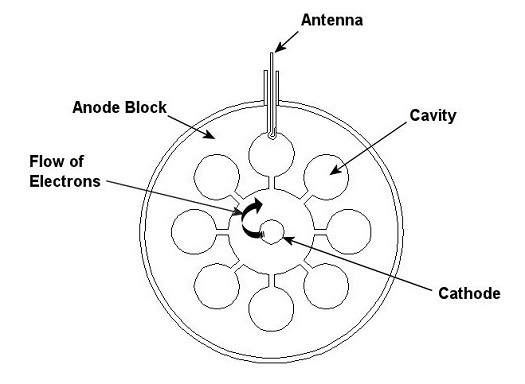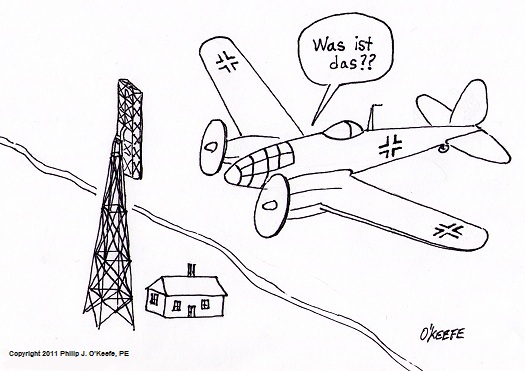| In the world of inventions it happens with some regularity that an invention to do one thing unexpectedly leads to a device that does something completely different. Take for example Edison’s phonograph. At the time, he was working on an invention to record the dots and dashes of Morse code telegraph messages so they could be sent out repeatedly without an operator having to tap them out each time and possibly making mistakes while doing so. Little did he know that this would lead to the evolvement of the phonograph and recording industries.
Another invention “by mistake” took place when the resonant cavity magnetron, originally developed for use with microwave radar, led to the development of the microwave oven. Last week we talked about how long wave radar, the first type of radar to be developed, was effectively used by the British to repel enemy air attacks during World War II. But long wave radar was large and cumbersome to employ, and it soon evolved into an improved version, the shorter wave, or, as we know it, microwave radar. So what is this resonant cavity magnetron that led to its creation? A pop bottle can give us a clue. Blow across the top of an empty glass pop bottle (or soda bottle, depending on the part of the country you’re from) and a familiar resonant sound results. The sound is created by an effect known as cavity resonance, and other bona fide musical instruments make use of this phenomenon to produce musical sounds. How this works is that where a cavity exists, when air molecules are introduced into it, the molecules are caused to resonate in and out of the cavity many times per second. This creates a sound at a certain frequency, that frequency depending on the shape and dimensions of the cavity, as well as the size of its opening. The resonant cavity magnetron, or magnetron for short, is actually a high powered vacuum tube that operates in a very similar fashion to a pop bottle, or any other musical device making use of a cavity, but instead of using air molecules to generate sound waves, it uses electrons to generate short wavelength radio waves, called microwaves. The magnetron contains a series of cavities that are arranged in a circle with the openings pointing inward towards the center, as shown in Figure 1. Figure 1 – Interior View of a Resonant-Cavity Magnetron Next week we’ll see what this interesting looking device has in common with the simple act of blowing air across the top of a pop bottle and what this all has to do with microwaves. _____________________________________________ |
Posts Tagged ‘RADAR’
The Heart of the Microwave Oven
Monday, July 18th, 2011The Origins of the Microwave Oven
Sunday, July 10th, 2011| Pop some corn, defrost meat, quickly heat a frozen dinner. What modern day miracle is capable of doing all this and more? The microwave oven, of course. They’ve become an integral part of modern kitchens and our lifestyle. Did you ever wonder how they came to be? We’ll have to turn back the hands of time over 70 years to the dark days of World War II to find out.
WWII began when Adolph Hitler’s Nazi regime conspired with Joseph Stalin’s Soviet Russia to invade Poland in September, 1939. From there, German forces went on to sweep across much of continental Europe, and even as far as North Africa and the Middle East. In the face of these and future war maneuvers, Great Britain remained our ally and a significant force to be dealt with. Although Hitler was intent on bringing the British Empire to it knees by means of aerial bombardment, he did not succeed. He failed to take into account the fact that the British Royal Air Force Fighter Command had a unique advantage over his German Luftwaffe– or Air Force to those of you not up on your German. The advantage was called RADAR, an acronym for RAdio Detection And Ranging. Thanks to this proprietary technology, the British Fighter Command was able to detect incoming German warplanes well in advance of their arrival over British soil, and this provided British pilots with enough time to scramble their fighter planes and get a jump on their attackers. Although horribly outnumbered, the Royal Air Force planes managed to inflict heavy casualties on the Luftwaffe. In fact, this Battle of Britain, as it came to be known, marked the first defeat of Hitler’s military forces during the war. So how does this modern marvel of RADAR work? Simply stated, it transmits radio waves from an antenna. When these waves strike an object, say an approaching German airplane, some waves are reflected back to a special receiver antenna. The reflected radio waves are then converted by the radar system into a “blip” on a viewing screen. A radar operator stands at the ready, trained in the art of interpreting radar blips. He or she is quickly able to assess the approaching object’s position, direction of travel, and speed of approach. Although the ideas that led to the development of radar had been around for some time before WWII, it wasn’t until the late 1930s that engineers began developing it for air defense purposes. They first developed what was called a long wave radar system, referring to the fact that the radio waves transmitted had a long wavelength, about 1.5 meters. The British, at the top of their game, had anticipated the Nazi threat and installed an array of these on their east coast by 1940. Although long wave radar worked well enough during the Battle of Britain, it required massive, land-based antennas to operate, which proved to be cumbersome. It also couldn’t give operators a good idea of how many planes were approaching. Then, just months before the beginning of the Battle of Britain, British researchers developed an ultra top secret device they dubbed a “resonant-cavity magnetron,” or magnetron for short. This magnetron was capable of producing short radio waves, in the range of 1 to 10 millimeters, and these came to be known as microwaves. The technology mastered in the magnetron opened the door to an improved radar system, one which became mobile. These systems were more easily installed on aircraft, ships, and land vehicles. Microwave radar was also found to be better at detecting small objects than its massive predecessor technology. Unfortunately, microwave radar couldn’t be put to use in time for the Battle of Britain, but it did play a pivotal role in the defeat of Axis, that is the opposing side’s, forces during the remainder of WWII. Next time we’ll take a closer look at the resonant cavity magnetron and find out how microwave radar led to the development of the famous oven that bears its name. _____________________________________________ |





